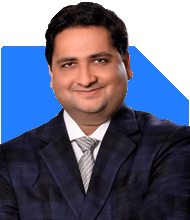Ulhas Joshi |280 Answers |Ask -Follow
Mutual Fund Expert - Answered on Feb 16, 2024
Prior to joining RankMF as CEO, he was vice president (sales) at IDBI Asset Management Ltd.
Joshi holds an MBA in marketing from Barkatullah University, Bhopal.... more

Hi Hemant, Good day. I am planning to start SIP's (55K per month) in the following Mutual funds for a horizon of 5-7 years to create 1 corpus. Could you please review and suggest if they look fine or need any changes/alternate funds. I am fine to take higher risks. 1 Quant Small Cap Fund Direct Plan Growth 3000 2 Nippon India Small Cap Fund Direct Growth 2500 3 HDFC Small Cap Fund Direct Growth 2500 4 Canara Robeco Small Cap Fund Direct Growth 3000 5 Quant Mid Cap Fund Direct Growth 3000 6 Motilal Oswal Midcap Fund Direct Growth 2000 7 HDFC Mid Cap Opportunities Direct Plan Growth 3000 8 Quant Infrastructure Fund Direct 3000 9 Quant Flexi Cap Fund Direct Growth 3000 10 Parag Parikh Flexi Cap Fund Direct Growth 6000 11 HDFC Flexi Cap Direct Plan Growth 5000 12 ICICI Prudential Technology Direct Plan Growth 3000 13 HDFC Retirement Savings Fund Equity Plan Direct Growth 5000 14 HDFC Balanced Advantage Fund Direct Plan Growth 2500 15 UTI Nifty200 Momentum 30 Index Fund Direct Growth 2500 16 Bandhan Nifty 50 Index Fund Direct Plan Growth 3000 17 Nippon India Growth Fund Direct Growth 5000 Thank You!
As your horizon is around 5 to 7 years, you can consider reducing exposure to pure equity funds and allocate higher amounts to hybrid funds like balanced advantage funds or multi asset/dynamic asset allocation funds.
I recommend you talk a financial planner who can understand your needs in depth to make a suitable plan for you.
You may like to see similar questions and answers below
Nikunj Saraf | Answer |Ask -Follow
Mutual Funds Expert - Answered on Apr 19, 2023
Hardik Parikh | Answer |Ask -Follow
Tax, Mutual Fund Expert - Answered on Apr 06, 2023
Ramalingam Kalirajan |10870 Answers |Ask -Follow
Mutual Funds, Financial Planning Expert - Answered on Apr 05, 2023
Ulhas Joshi |280 Answers |Ask -Follow
Mutual Fund Expert - Answered on Oct 19, 2023
Dev Ashish | Answer |Ask -Follow
MF Expert, Financial Planner - Answered on Oct 21, 2023
Dr Dipankar Dutta |1837 Answers |Ask -Follow
Tech Careers and Skill Development Expert - Answered on Dec 05, 2025
Dr Shyam Jamalabad |108 Answers |Ask -Follow
Dentist - Answered on Dec 05, 2025
Dr Shyam Jamalabad |108 Answers |Ask -Follow
Dentist - Answered on Dec 05, 2025
Dr Shyam Jamalabad |108 Answers |Ask -Follow
Dentist - Answered on Dec 05, 2025
Dr Dipankar Dutta |1837 Answers |Ask -Follow
Tech Careers and Skill Development Expert - Answered on Dec 05, 2025
Ulhas Joshi |280 Answers |Ask -Follow
Mutual Fund Expert - Answered on Dec 05, 2025
Dr Dipankar Dutta |1837 Answers |Ask -Follow
Tech Careers and Skill Development Expert - Answered on Dec 04, 2025
Ravi Mittal |676 Answers |Ask -Follow
Dating, Relationships Expert - Answered on Dec 04, 2025
Anu Krishna |1745 Answers |Ask -Follow
Relationships Expert, Mind Coach - Answered on Dec 04, 2025
Anu Krishna |1745 Answers |Ask -Follow
Relationships Expert, Mind Coach - Answered on Dec 04, 2025




























